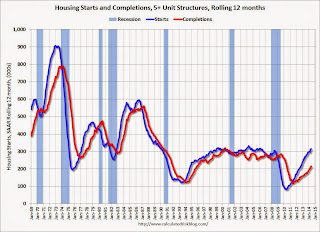This was just the fourth month with starts at over a 1 million annual pace since early 2008 (Seasonally adjusted annual rate, SAAR). Starts were over 1 million in November and December of 2013 - and then starts were a little weaker in Q1 - and then were at or above 1 million in April and May.
The weak start to 2014 was due to several factors: severe weather, higher mortgage rates, higher prices and probably supply constraints in some areas.
It is also important to note that the year-over-year comparison will be easier for housing starts for the next several months. There was a huge surge in housing starts early in 2013, and then a lull - and finally more starts at the end of the year.
The bottom line is the housing recovery is ongoing and will continue.
 Click on graph for larger image.
Click on graph for larger image.This year, I expect starts to continue to increase (Q1 will probably be the weakest quarter) - and more starts combined with an easier comparison means starts will probably be up double digits year-over-year.
This graph shows the month to month comparison between 2013 (blue) and 2014 (red).
Below is an update to the graph comparing multi-family starts and completions. Since it usually takes over a year on average to complete a multi-family project, there is a lag between multi-family starts and completions. Completions are important because that is new supply added to the market, and starts are important because that is future new supply (units under construction is also important for employment).
These graphs use a 12 month rolling total for NSA starts and completions.
 The blue line is for multifamily starts and the red line is for multifamily completions.
The blue line is for multifamily starts and the red line is for multifamily completions. The rolling 12 month total for starts (blue line) has been increasing steadily, and completions (red line) are lagging behind - but completions will continue to follow starts up (completions lag starts by about 12 months).
This means there will be an increase in multi-family completions in 2014, but probably still below the 1997 through 2007 level of multi-family completions. Multi-family starts will probably move more sideways in 2014.
 The second graph shows single family starts and completions. It usually only takes about 6 months between starting a single family home and completion - so the lines are much closer. The blue line is for single family starts and the red line is for single family completions.
The second graph shows single family starts and completions. It usually only takes about 6 months between starting a single family home and completion - so the lines are much closer. The blue line is for single family starts and the red line is for single family completions.Starts have been moving up (but the increase has slowed recently), and completions have followed.
Note the exceptionally low level of single family starts and completions. The "wide bottom" was what I was forecasting several years ago, and now I expect several years of increasing single family starts and completions.
No comments:
Post a Comment
Note: Only a member of this blog may post a comment.